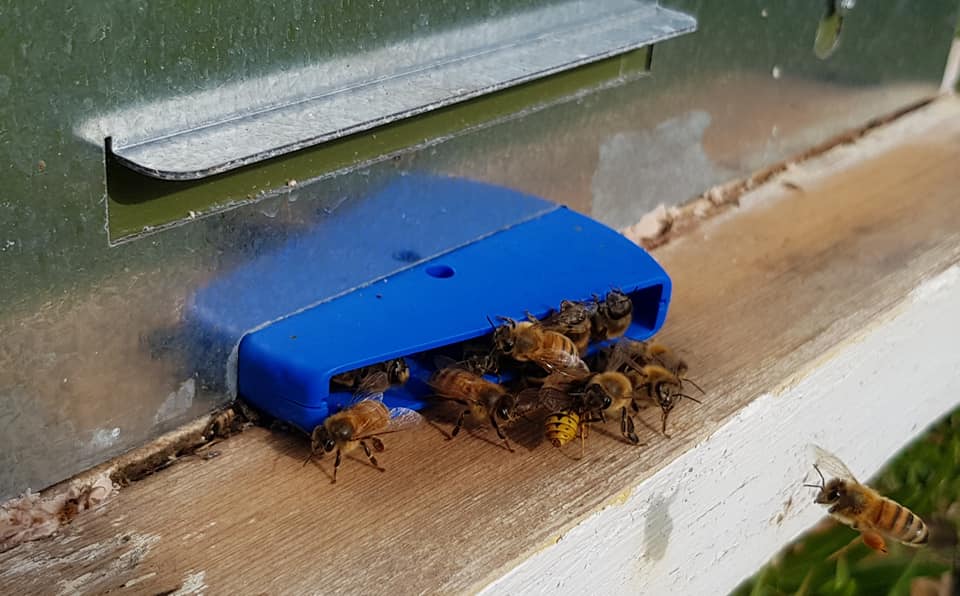HiveGate, a wasp-protection entrance with far-reaching benefits
A simple, low-cost adjustment to any honey bee hive entrance helps bees protect against wasps (yellow jackets), robber bees and other would-be intruders. By creating a tunnel from the entrance of the hive to beneath the cluster, HiveGate not only confuses intruders, it also seems to help bees to regulate the temperature and humidity of their nest much more precisely, thereby potentially boosting their health and productivity.

HiveGate, a 27cm long and 7cm wide insert, is placed in an existing hive entrance. Bees entering through HiveGate emerge directly under the broodnest cluster and can therefore deliver their foraging load directly where it is needed. In contrast, pest intruders that succeed in getting past the guard bees at the front entrance quickly become confused by HiveGate, are unable to make a quick exit and are easily dealt with by the colony.

Paulo Mielgo, technical director at Vita Bee Health, says: “In-hive video footage shows just how disorientated and vulnerable hive intruders become when they enter via HiveGate. The honey bee colony quickly becomes habituated to the tunnel entrance. However, intruders emerging from HiveGate are quickly surrounded and dispatched by the bees as they struggle to find the exit to the hive. Any that do escape do so empty-handed and are unlikely to return.”
HiveGate has been developed in New Zealand by Kyle Atkinson, of BeeIQ Solutions. With a lifetime’s experience working with and closely observing a variety of animals, Kyle became fascinated by honey bees. When his colonies were severely attacked by wasps, he needed a solution and developed the highly successful HiveGate.
HiveGate immediately worked against the wasps, but there were more revelations to come. Kyle’s close and continued observation of the colony over 14 months via continuous in-hive videos and hive data monitoring revealed that HiveGate may have much more than a portcullis effect.
Kyle explains: “By comparing video activity of two colonies with and without a HiveGate, I noticed differences in the bees’ behaviour. I believe that they are using the HiveGate entrance to help regulate their internal hive environment. We are currently analysing the video and other data to establish the extent and nature of this surprising and potentially highly beneficial effect. Results are now being analysed with a view to publication.”
Having studied the videos, Paulo Mielgo says: “While simplicity has been key to this hive entrance innovation, there are signs of sophisticated behaviour of bees. HiveGate may be helping rather than hindering bees in delivering nectar, pollen and water to the colony and even enabling them to regulate their nest as they have in the wild for millennia. A variety of recent studies has shown the importance of thermoregulation of the hive, and we look forward to Kyle’s results to see the impact of HiveGate. Meantime, it’s a great way to keep wasps out of the hive, especially as the season comes to a close.”

The colony reacts to the low outside temperature (here 8°C) by retracting from the entrance during the late afternoon until the morning. The bees are tucked up high on the frames and do not defend the entrance leaving the whole surface area around the cluster exposed to the cold. The bees cannot move or react until the colony warms up, thereby leaving a large area for wasps to enter and start robbing.

(HiveGate floors removed to reveal bee behaviour within)
With HiveGate, bees are in control of their entrance and their internal environment. Instead of retracting up high in the frames, the bees ‘work the door’, closing or blocking the door as they choose. By creating a ‘valve’ with their bodies, they can control air can flow in and out. Only the small number of bees plugging the door are exposed to the outside cold; the rest of the cluster is unaffected. (Without HiveGate, a cluster retracted high in the frames exposes its full surface area to the cold coming in through the open entrance. Defence against intruders is much more efficient as the bees are always guarding the HiveGate door and intruders cannot enter unnoticed. With HiveGate the bees control the environment inside the hive, rather than being controlled by it, and show a proactive behaviour using HiveGate as a tool, instead of a reactive behaviour to cope with an ‘open-door’ system.

Bees form a ‘slipstream’ drawing air in or out. In an ungated hive, bees spread out over a huge area flapping their wings, requiring many more bees to achieve efficient ventilation.
